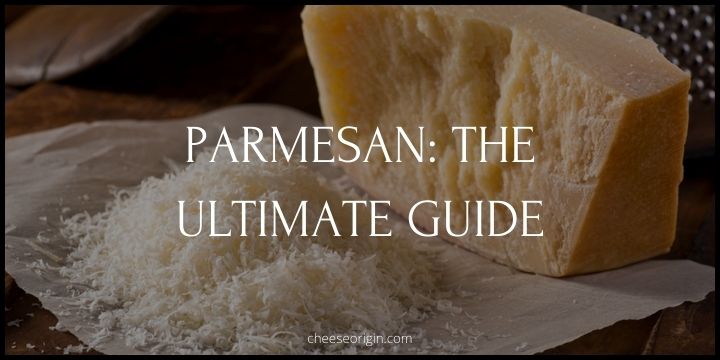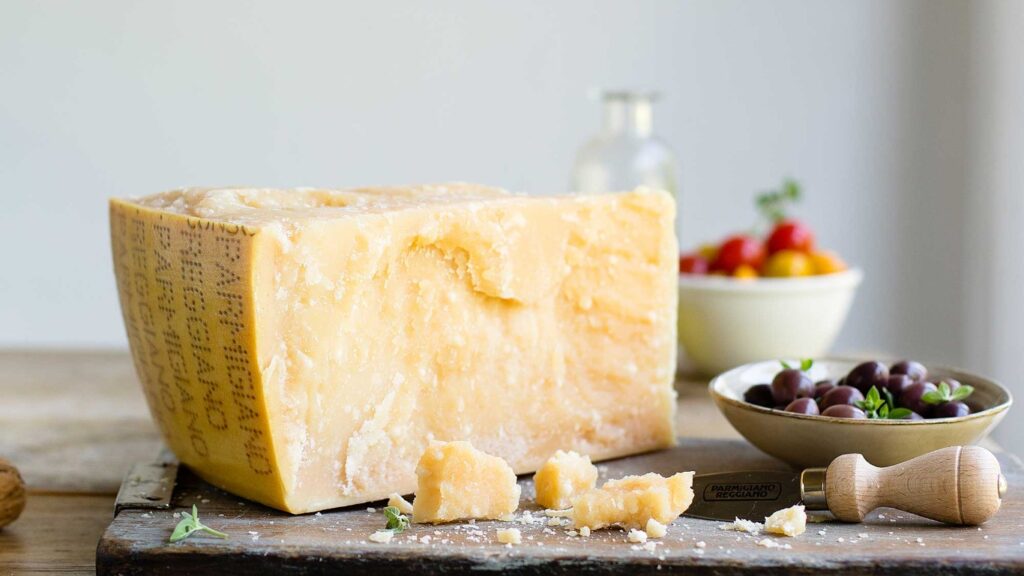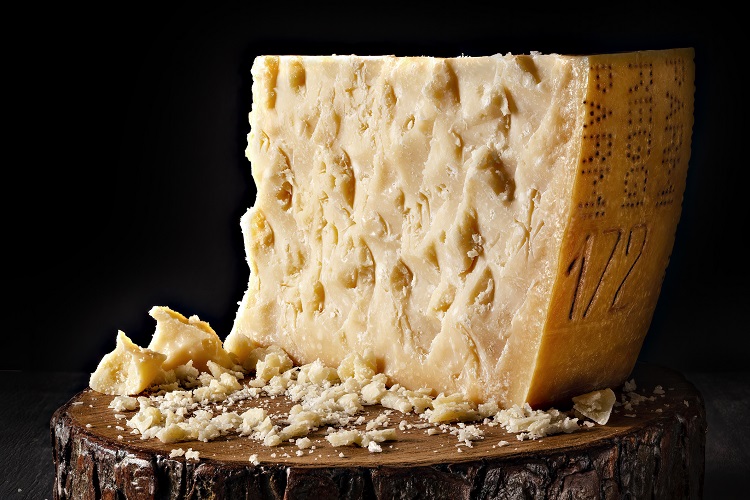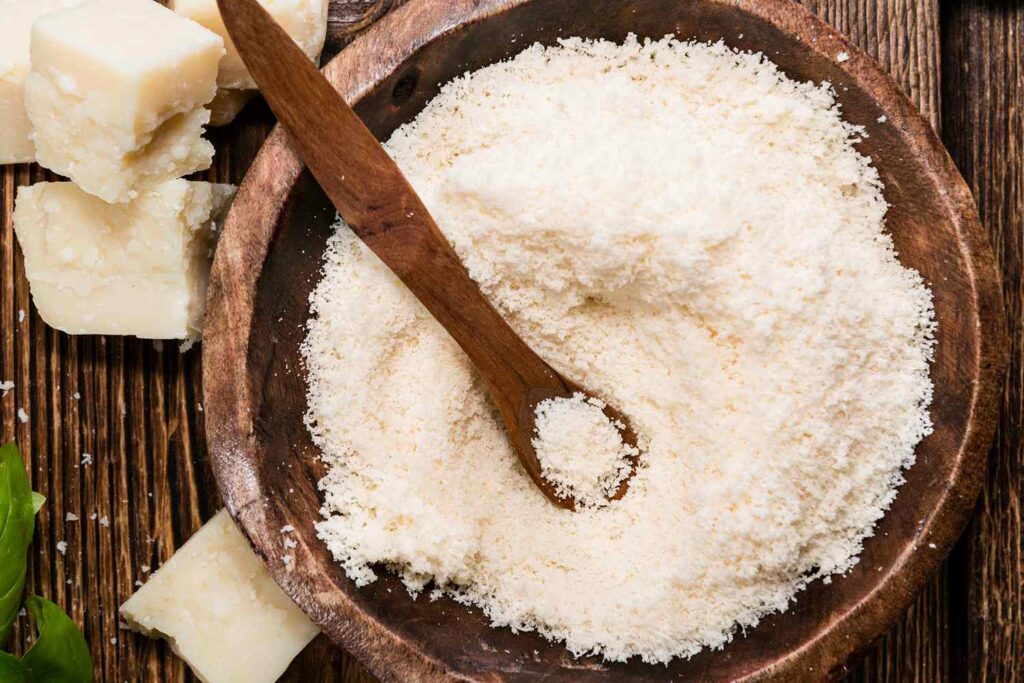What is Parmesan? More Than Just a Cheese, A Symbol of Italian Heritage

If you’re a cheese lover, chances are, you’ve already had a tryst with the inimitable Parmesan. Renowned for its robust flavor, Parmesan has been gracing our pastas, salads, and risottos, adding that extra touch of deliciousness we can’t seem to get enough of. But how much do you really know about this cheese powerhouse?
In this guide, we’ll delve into the world of Parmesan, exploring its rich history, the intricate production process, and the best ways to savor this Italian delicacy.
We’ll also dispel common misconceptions and help you distinguish between Parmesan and its often-confused counterpart, Parmigiano-Reggiano.
So prepare your taste buds for a cheesy adventure as we embark on a journey to appreciate Parmesan in all its glory.
Quick Facts About Parmesan
| Fact | Description |
|---|---|
| Origin | Italy, specifically the regions of Parma, Reggio Emilia, Modena, and parts of Bologna and Mantova |
| Milk Source | Cow’s milk |
| Texture | Hard and granular |
| Flavor | Nutty and fruity with a strong, savory flavor |
| Color | Pale yellow |
| Aging Process | Aged for at least 12 months, but often much longer. Some Parmesan cheeses are aged for over 24 months |
| Protected Designation of Origin | Parmigiano-Reggiano, often referred to as the “King of Cheeses,” has PDO status in the European Union |
| Historical Origins | The production of Parmesan dates back to at least the Middle Ages |
| Uses | Grated over pasta, risotto, and pizza, used in Caesar salad, or eaten on its own with a drizzle of balsamic vinegar |
What is Parmesan?

Parmesan, more formally known as Parmigiano-Reggiano, is a hard, granular cheese native to Italy. It is named after the regions where it is produced, which include the provinces of Parma, Reggio Emilia, and Modena, as well as parts of Bologna and Mantua.
The production of Parmesan involves mixing the raw milk from the morning milking with the naturally skimmed milk from the previous evening’s milking. This part-skim mixture is then heated and coagulated into curds, which are pressed and formed into wheels of cheese.
These wheels are then aged for a minimum of 12 months, and often up to 36 months or longer. During this aging process, the cheese develops its characteristic flavor profile and texture. The end result is a cheese that is pale golden in color, with a hard, grainy texture.
In terms of flavor, Parmesan is known for its rich, sharp, nutty taste with a strong savory note and a slightly sweet finish. It is often used grated over pasta dishes, stirred into soups and risottos, or eaten on its own as part of a cheese plate.
Genuine Parmigiano-Reggiano cheese can be identified by the dotted inscriptions on its rind, which attest to its authenticity and place of origin. It’s a versatile cheese that has become a staple in both Italian cuisine and global gastronomy.
How is Parmesan cheese different from regular cheese?
Parmesan cheese, specifically Parmigiano-Reggiano, is a type of hard, granular cheese that’s distinct from other cheeses due to several factors:
- Origin and Production: Parmesan cheese originates from a specific region in Italy, namely Parma, Reggio Emilia, Modena, and parts of Bologna and Mantova. The production process follows strict traditional methods defined by the Italian law and the Consorzio del Formaggio Parmigiano-Reggiano. The milk used comes from cows fed on a particular diet, without any additives or fermented feeds.
- Aging Process: Parmesan cheese is aged for a minimum of 12 months, with some varieties being aged for 24 months or more. This extended aging process contributes to its distinct flavor and texture.
- Texture and Flavor: Parmesan has a hard, gritty texture and a rich, nutty, and slightly fruity flavor. It’s known for its deep umami taste, which enhances the flavor of various dishes.
- Usage: Parmesan is often used as a grating cheese over pasta dishes, soups, and salads. It is also eaten on its own as a snack, especially the well-aged varieties.
- Nutritional Value: Parmesan is high in calcium and protein, and despite its rich flavor, it’s low in fat and cholesterol compared to many other cheeses.
Remember, not all cheese labeled as “Parmesan” follows these standards, especially outside Europe. For the authentic experience, look for “Parmigiano-Reggiano” on the label.
Also read: The Differences between Organic and Regular Cheese
Is Parmesan cheese healthier than regular cheese?
Parmesan cheese, specifically Parmigiano-Reggiano, is often considered healthier than some other types of cheese. Here’s why:
- Protein Content: Parmesan cheese has a high protein content. It contains more protein per gram than many other cheeses.
- Mineral and Vitamin Content: It’s rich in essential minerals like calcium, which is crucial for bone health. It also contains vitamins such as vitamin A and vitamins B6 and B12.
- Digestibility: Parmesan cheese is often easier to digest compared to other cheeses.
- Safety: Parmigiano-Reggiano is considered a very safe cheese due to the strict regulations and quality controls involved in its production.
Parmesan Nutrition Facts
The key nutrients in a 100 grams serving of Parmesan cheese:
| Nutrient | Quantity |
|---|---|
| Calories | 392 – 431 kcal |
| Protein | 28 – 32.4g |
| Total Fat | 27.84 – 39g |
| Saturated Fat | Not Specified |
| Cholesterol | Not Specified |
| Sodium | Not Specified |
| Potassium | Not Specified |
| Total Carbohydrate | 0.1 – 14g |
| Dietary Fiber | 0g |
| Calcium | Not Specified |
| Vitamin A | Not Specified |
What is the difference between Parmesan cheese and Parmigiano-Reggiano?
While the terms “Parmesan” and “Parmigiano-Reggiano” are often used interchangeably, there is a significant difference between the two.
| Parmesan Cheese | Parmigiano-Reggiano | |
|---|---|---|
| Origin | Can be made anywhere in the world | Strictly made in specific regions in Italy |
| Production Process | May not follow traditional Italian methods | Follows strict traditional methods defined by Italian law |
| Aging Process | Varies, often less than 12 months | Aged for a minimum of 12 months, often 24 months or more |
| Texture and Flavor | Can vary greatly | Hard, granular texture with a rich, nutty, slightly fruity flavor |
| Usage | Used as a grating cheese over various dishes | Used both as a grating cheese and consumed on its own |
| Certification | No specific certification required | Certified by the Consorzio del Formaggio Parmigiano-Reggiano |
| Nutritional Value | Can vary | High in calcium and protein, low in fat and cholesterol |
| Authenticity Label | “Parmesan” | “Parmigiano-Reggiano” |
Parmigiano-Reggiano:

Parmigiano-Reggiano is a specific type of hard, granular cheese that comes from particular regions in Italy – Parma, Reggio Emilia, Modena, and parts of Bologna and Mantova.
The production process is strictly regulated by Italian law and the Consorzio del Formaggio Parmigiano-Reggiano, a consortium that oversees its production and quality.
It must be made using traditional methods and aged for at least 12 months, with many wheels aged for 24 months or more.
>> Click here to read our in-depth guide on Parmigiano-Reggiano
Parmesan:

On the other hand, Parmesan is the French-derived name for this type of cheese and is used outside Europe to refer to cheeses that are similar to Parmigiano-Reggiano.
However, these cheeses do not have to adhere to the same strict production standards. They can be made anywhere in the world, may not follow the traditional Italian recipe, and might not be aged as long.
As a result, while they aim to mimic the flavor and texture of Parmigiano-Reggiano, there can be considerable variation in quality.
So, while all Parmigiano-Reggiano is Parmesan, not all Parmesan is Parmigiano-Reggiano.
For the authentic experience, look for the term “Parmigiano-Reggiano” on the label and check for its certification mark.
Is Parmesan cheese non dairy?
Parmesan cheese is not non-dairy. It is made from cow’s milk, which is a dairy product.
However, Parmigiano Reggiano, a type of Parmesan cheese, does not contain lactose or galactose, making it suitable for people with lactose intolerance.
For those seeking a completely non-dairy alternative to Parmesan, there are vegan versions available on the market. These are often made from ingredients like nutritional yeast, nuts, and spices to mimic the flavor of Parmesan.
Also read: Savor the Flavor: 20 Cheeses with the Least Lactose
The 7 Reasons Why Authentic Parmesan is So Expensive
Parmesan cheese, especially the authentic Parmigiano-Reggiano, is expensive due to these 7 factors:
- Location and Production: Authentic Parmesan cheese is made in specific regions of Italy following strict traditional methods defined by Italian law. This limitation on where it can be produced adds to its cost.
- Quality of Ingredients: It requires a significant amount of high-quality milk to make Parmesan cheese. For instance, it takes about 16 liters of milk to make one kilogram of the cheese.
- Aging Process: Parmesan cheese is aged for a minimum of 12 months, with some varieties being aged for 24 months or more. The storage and aging process increases the cost.
- Labor Intensive: The production process is labor-intensive, requiring skilled cheesemakers to adhere to meticulous standards.
- Certification: Each wheel of Parmigiano-Reggiano is inspected and if it passes quality tests, it’s branded with a certification mark. This certification process adds to the cost.
- Weight and Size: A full wheel of Parmigiano-Reggiano can weigh around 88 pounds, contributing to the cost, especially when considering shipping and handling.
- Regulations: Strict guidelines and regulations control the production of Parmesan cheese, adding to the overall cost of production.Therefore, while you may pay a higher price for authentic Parmesan cheese, you’re paying for its quality, tradition, and unique flavor profile.
What are the 7 different types of Parmesan cheese?
The 3 Different Types of Parmigiano-Reggiano
While “Parmesan” is a term used to describe a variety of hard, aged cheeses, the authentic Parmigiano-Reggiano from Italy is considered the original and finest.
The differences in types usually come down to the aging process. Here are some categories based on aging:
| Type of Parmesan | Aging Duration | Texture | Flavor |
|---|---|---|---|
| Parmigiano-Reggiano Fresco | 14-18 months | Softer | Milder, creamier |
| Parmigiano-Reggiano Vecchio | 18-24 months | Firmer | More robust |
| Parmigiano-Reggiano Stravecchio | 24-36 months or longer | Very hard | Rich, complex |
The 4 Common Types of Parmesan Cheese
However, there are many parmesan-style cheeses produced around the world that aren’t authentic Parmigiano-Reggiano but are often referred to as “Parmesan”. These include:
| Type of Cheese | Origin | Description | Flavor | Aging Duration |
|---|---|---|---|---|
| Grana Padano | Italy | Similar to Parmigiano-Reggiano but produced under less strict regulations. | Similar to Parmigiano-Reggiano | Varies |
| Pecorino Romano | Italy | Made from sheep’s milk rather than cow’s milk. | Sharper, saltier than Parmigiano-Reggiano | Varies |
| Reggianito | Argentina | Developed by Italian immigrants as a substitute for Parmigiano-Reggiano. | Slightly different from Parmigiano-Reggiano | Typically aged for less time |
| Domestic (U.S.) Parmesan | United States | Can vary widely in quality. Some are mass-produced, others are artisanal cheeses. | Varies | Some are aged for a shorter time, others for a longer period |
Is Parmesan cheese healthier than mozzarella?
The healthiness of Parmesan and Mozzarella cheese can depend on your dietary needs and what you’re looking for in a cheese. Both cheeses have their own nutritional benefits:
| Nutritional Aspect | Parmesan | Mozzarella |
|---|---|---|
| Calories (per 100g) | 392 calories [source, source] | 280-318 calories [source, source] |
| Fat Content | High in saturated fat, slightly less than mozzarella [source] | High in saturated fat, slightly more than Parmesan (5% more by weight) [source] |
| Vitamins and Minerals | Good source of Vitamin B12 and a great source of Phosphorus [source] | Has significantly more Vitamin A [source] |
| Sodium | Higher sodium content [source] | Lower in sodium, beneficial for those monitoring their sodium intake [source] |
| Probiotics | Not mentioned | Contains probiotics that may benefit your immune system [source] |
| Flavor | Stronger flavor which may influence the amount used and thus the overall caloric and nutritional intake [source] | Milder flavor [source] |
It’s important to remember that both cheeses can be part of a balanced diet when consumed in moderation.
>> Click here to read our in-depth guide to Mozzarella
Which is better Parmesan or Pecorino Romano?
Both cheeses have unique characteristics that can enhance different recipes:
Parmesan:
- Made from cow’s milk
- Has a more golden color and is very hard and dry
- Tends to have a milder, nuttier flavor
Romano (Pecorino Romano):
- Made from sheep’s milk
- Is whiter and slightly softer than Parmesan
- Has a sharper and saltier taste than Parmesan
Romano is often used in traditional Roman foods like pasta all’amatriciana, carbonara, and more due to its strong flavor.
Meanwhile, Parmesan’s milder flavor makes it a versatile cheese that can be used in a variety of dishes.
What’s the closest cheese to Parmesan?
| Cheese | Description on how it may be similar to Parmesan |
|---|---|
| Grana Padano | This is a hard, grainy cheese from Italy with a complex fruity-nutty taste that’s similar to Parmesan. It’s typically less crumbly and milder than Parmesan, making it a great substitute in recipes. |
| Pecorino Romano | Another hard Italian cheese, Pecorino Romano is made from sheep’s milk, which gives it a sharper, saltier flavor than Parmesan. Its texture and ability to be grated make it a suitable Parmesan alternative. |
| Piave | Piave is an Italian cow’s milk cheese named after the river Piave. It has a dense texture and a sweet, full-bodied flavor, somewhat similar to Parmesan but with a slightly sweeter profile. |
| Asiago | Asiago is a cow’s milk cheese from Italy that can vary in consistency depending on its aging. The mature version (Asiago d’allevo) is crumbly and full-flavored like Parmesan, which makes it a good substitute. |
| Manchego | This is a Spanish cheese made from sheep’s milk. It’s not as hard as Parmesan but offers a similar nutty and intense flavor. It’s an excellent grating cheese, making it a good stand-in for Parmesan. |
| Romano Cheese | Romano is a term for a family of Italian cheeses. They are generally hard, salty, and excellent for grating, which makes them similar to Parmesan. |
| American Grana | American Grana is a hard, aged cheese inspired by Italian Grana Padano. It’s crafted to have a sweet, nutty flavor similar to Parmesan. |
| Dry Jack | Dry Jack is a harder, aged version of Monterey Jack with a similar texture to Parmesan. It has a rich, nutty, sharp flavor that can substitute Parmesan in many dishes. |
| Reggianito | Reggianito is an Argentinean cheese similar to Parmesan. It has a hard, granular texture and a strong, slightly salty flavor. Like Parmesan, it is an excellent grating cheese. |
How do you eat Parmesan cheese? A pairing guide
Parmesan is a versatile ingredient that pairs well with a variety of foods and beverages. Here’s a quick guide:
- Fruits: Fresh fruits like apples, pears, and grapes complement the savory taste of Parmesan. Dried fruits like figs and apricots also make a delightful pairing.
- Breads & Crackers: Whole grain breads, water crackers, and baguettes are great for serving with Parmesan.
- Charcuterie: Prosciutto, salami, and other cured meats balance the richness of Parmesan.
- Nuts & Olives: Almonds, walnuts, and olives can add a contrasting texture and flavor.
- Honey & Jams: A drizzle of honey or a spoonful of fig jam or cherry preserves can bring out the sweetness in Parmesan, providing a delightful contrast to its salty, nutty flavor.
Also read: 11 Best Crackers that Pair Well with Cheese
What beverage goes well with Parmesan?
| Beverage Type | Examples | Description |
|---|---|---|
| Wine | Chianti, Lambrusco, Albana Metodo Classico Brut | Full-bodied, dry, or sparkling wines that complement the nutty and salty flavor of Parmesan cheese. |
| Cocktails | Parmesan- and thyme-infused gin cocktail, Parmesan Espresso Martini | Unique concoctions that blend the flavors of Parmesan with various spirits and mixers. |
| Spirits | Whiskey, particularly brown liquor | Less traditional pairings that can offer an interesting taste experience. |
| Non-Alcoholic | Sparkling water, unsweetened iced tea | Refreshing accompaniments to Parmesan cheese that do not contain alcohol. |
Also read: Best Wine and Cheese Pairings: The Ultimate Guide
Frequently Asked Questions
1. Is it OK to eat a lot of Parmesan cheese?
While Parmesan cheese is undeniably delicious and can add a boost of flavor to many dishes, it’s important to consume it in moderation.
Parmesan is high in calories and saturated fat, which can contribute to weight gain and heart disease if consumed in large quantities. Moreover, it contains a significant amount of sodium, which can lead to increased blood pressure and other health issues for those who are sensitive to salt.
However, Parmesan is also a good source of protein and calcium, as well as vitamins like B12. As with any food, balance is key.
Enjoying Parmesan cheese as part of a varied, nutrient-rich diet can be perfectly healthy, but it’s best to keep an eye on portion sizes to ensure you’re not overdoing it.
2. Why is Parmesan cheese so addicting?
The addictive nature of Parmesan cheese can be attributed to a protein called casein. When digested, casein breaks down into compounds known as casomorphins, which have an opioid effect.
Casomorphins stimulate the dopamine receptors in our brain, the same neurotransmitters responsible for feeling pleasure. This stimulation can lead to a craving for more, making it hard to resist reaching for another sprinkle of Parmesan.
Additionally, Parmesan cheese is rich in glutamate, a naturally occurring amino acid that enhances the savory, umami taste of foods, further increasing its addictive qualities.
However, while the term ‘addictive’ is used, it’s important to note that cheese doesn’t possess the same characteristics or harmful consequences as drug addiction.
So, while you might find yourself reaching for an extra helping of Parmesan, it’s more about pleasure than actual addiction.
Source:
- Is Cheese Addictive? – Healthline
- Say cheese? All the time? Maybe you have an addiction. – Washington Post
- Millions of People May Be Suffering From Cheese Addiction – Sentient Media
- Why is Cheese Addictive? Should I Stop Eating It? – Ora Organic
3. Does Parmesan cheese have to be refrigerated?
Yes, Parmesan cheese should be refrigerated. Once opened, it’s best to keep Parmesan cheese in the refrigerator to maintain its quality and prevent it from drying out.
It should be stored in an airtight container or wrapped tightly in plastic wrap or aluminum foil. Unopened, vacuum-sealed packages of Parmesan cheese can be kept in the pantry at room temperature, but should be refrigerated after opening.
>> Click here to learn about the best way to store cheese
Conclusion
Delving into the world of Parmesan cheese opens up a cornucopia of taste experiences. From its rich, savory flavor to its versatile pairings, Parmesan truly is a testament to the art of cheese-making.
Also read: The Science of Cheesemaking: A Journey from Milk to Artisanal Delight
Whether you’re pairing it with a full-bodied Chianti, savoring it alongside a Parmesan-infused gin cocktail, or enjoying it with a simple glass of iced tea, the joy of Parmesan lies in its ability to elevate any culinary experience.
So don’t be afraid to experiment and explore – your ultimate Parmesan pairing is waiting to be discovered.
Also read:
- The Ultimate Guide to Colby Cheese: America’s Own Dairy Delight
- Cheese Curds: The Unsung Heroes of the Dairy World
- Gorgonzola: A Guide to Italy’s Beloved Blue Cheese
- Cheese Balls 101: A Journey through Flavors and Textures
- Is Processed Cheese Good or Bad? Let’s Find Out!
- What Kind of Cheese is Used on Nachos?
- What Pairs Well with Cheddar: The Ultimate Guide
- 12 Most Popular Cheeses in the World





